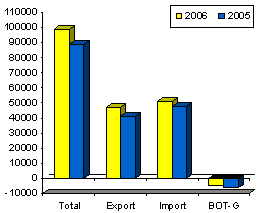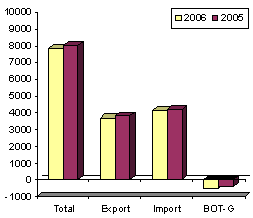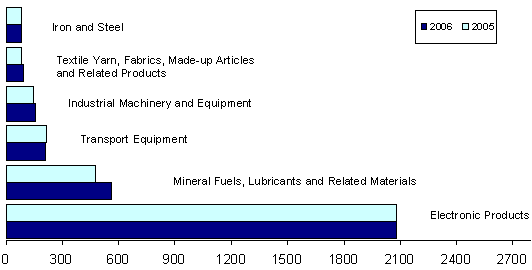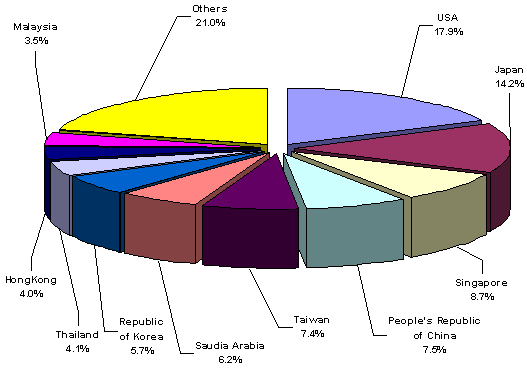| |||||||||||||||||||||||||||||||||||||||||||||||
| |||||||||||||||||||||||||||||||||||||||||||||||
r - revised
Top 10 Philippine Imports from All Countries: December 2006 | |||
Gainers | Losers | ||
| Mineral Fuels, Lubricants and Related Materials | 17.7 | Telecommunication Equipment and Electrical Machinery | -19.7 |
| Textile Yarn, Fabrics, Made-Up Articles and Related Products | 9.2 | Cereal and Cereal Preparations | -12.2 |
| Plastics in Primary and Non-Primary Forms | 8.6 | Organic and InorganicChemicals | -9.4 |
| Industrial Machinery and Equipment | 3.4 | Transport Equipment | -6.6 |
| Iron and Steel | 1.9 | ||
| Electronic Products | 0.1 | ||
JANUARY TO DECEMBER 2006 TOTAL TRADE STANDS AT $98.558 BILLION
Total external trade in goods for January to December 2006 reached $98.558 billion, representing an 11.1 percent increment from $88.673 billion during the same 12-month in 2005. Similarly, total imports grew by 8.7 percent to $51.522 billion from $47.418 billion. Exports, on the other hand, registered an increase of 14.0 percent to aggregate dollar revenue of $47.037 billion from $41.255 billion in the previous year. Balance of trade in goods (BOT-G) deficit for the Philippines reached $4.485 billion, which is lower compared to last years deficit of $6.163 billion.
Figure 1A Philippine Trade Performance in January - December : 2005 and 2006
(F.O.B. Value in Million US Dollar)

Figure 1B Philippine Trade Performance in December : 2005 and 2006
(F.O.B. Value in Million US Dollar)

DECEMBER 2006 IMPORTS REGISTER 1.3 PERCENT DECLINE
Total merchandise trade for December 2006 went down by 2.4 percent to $7.846 billion from $8.037 billion during the same period last year. Dollar-inflow generated by exports reached $3.689 billion, or 3.6 percent lower from last years $3.827 billion. Expenditures for imported goods likewise decrease by 1.3 percent to $4.157 billion from $4.209 billion in December 2005. The balance of trade in goods (BOT-G) registered a deficit at $467 million, higher than last years deficit of $382 million.
ELECTRONIC PRODUCTS ACCOUNT FOR 50.0 PERCENT OF IMPORT BILL
Accounting for 50.0 percent of the aggregate import bill, payments for Electronic Products amounted to $2.079 billion or 0.1 percent growth over last year's figure of $2.078 billion. Compared to the previous months level, purchases shrank by 4.9 percent from $2.186 billion. Among the major groups of electronic products, Components/Devices (Semiconductors) had the biggest share of 40.1 percent. However, it recorded a decrease of 1.2 percent to $1.668 billion from $1.688 billion during the same month in 2005.
Imports of Mineral Fuels, Lubricants and Related Materials in December ranked second with a 13.4 percent share and posted a growth of 17.7 percent to $558.30 million over the previous years level of $474.27 million. The increase was due to the high volume of importation on motor spirit (gasoline), diesel oil and aviation gasoline.
Transport Equipment, contributing 4.9 percent to the total bill, was the RPs third top import for the month with payments placed at $204.44 million from last years $218.97 million or a decrease of 6.6 percent.
Industrial Machinery and Equipment, accounting for a 3.7 percent of the total imports, ranked fourth as foreign bill amounted to $153.88 million or a year-on-year growth of 3.4 percent from $148.79 million last year. The increase was due to the importation of parts not elsewhere classified of machines and mechanical appliances having individual functions.
Textile Yarn, Fabrics, Made-Up Articles and Related Products, ranked fifth comprising 2.1 percent of the total imports; registered $88.52 million worth of imports or an increase of 9.2 percent from its year ago level of $81.10 million, which is mainly due on the importation of knitted/crocheted fabrics.
Iron and Steel recorded a share of 2.0 percent at $82.73 million worth of imports, which grew by 1.9 percent.
Rounding up the list of the top imports for December 2006 were Plastics in Primary and Non-Primary Forms with $74.83 million worth of imports and registered the year-on-year growth of 8.6 percent due to the importation of polypropylene and polyethylene, both in primary forms; Telecommunication Equipment and Electrical Machinery, $64.77 million; Organic and Inorganic Chemicals, $60.26 million; and Cereals and Cereal Preparations, $51.24 million.
Aggregate payment for the countrys top ten imports for December 2006 reached $3.418 billion or 82.2 percent of the total bill.
Figure 2 Philippine Top Imports in December : 2005 and 2006
(F.O.B. Value in Million US Dollar)

RAW MATERIALS AND INTERMEDIATE GOODS ACCOUNT FOR 43.8 PERCENT OF THE TOTAL IMPORTS
Accounting for 43.8 percent of the total imports, payments in December 2006 for Raw Materials and Intermediate Goods amounted to $1.820 billion or 0.04 percent decrease over last year's figure of $1.821 billion. Compared to the previous months level, purchases went down by 5.3 percent from $1.923 billion. Semi-Processed Raw Materials valued at $1.689 billion had the biggest share of 40.6 percent.
Capital Goods, which comprised 33.3 percent of the total imports, shrank by 4.4 percent year-on-year, to $1.384 billion from $1.448 billion. The major share went to Telecommunication Equipment and Electrical Machinery with an 18.7 percent share of the total imports in December 2006 and billed at $778.95 million.
Mineral Fuels, Lubricants and Related Materials with a 13.4 percent share, increased by 17.7 percent to $558.30 million from $474.27 million in December 2005.
Purchases of Consumer Goods amounted to $313.35 million or a growth of 26.1 percent from $248.44 million in December 2005, while Special Transactions declined by 63.2 percent to $80.25 million from $217.94 million.
Figure 3 Philippine Imports by Major Type of Goods in December: 2005 and 2006

UNITED STATES CORNERS 17.9 PERCENT OF DECEMBER IMPORT BILL
United States of America (USA) continued to be the countrys biggest source of imports for December 2006 with a 17.9 percent share of the total import bill. However, its total bill declined by 10.8 percent to $742.01 million in December 2006 from $831.41 million in December 2005. Exports to USA amounted to $674.34 million, yielding a two-way trade value of $1.416 billion and a trade deficit for RP at $67.66 million.
Japan, on the other hand, came second accounting for 14.2 percent of the total import bill, down by 13.0 percent to $589.26 million from $676.93 million during the same month in 2005. Exports to Japan amounted to $534.52 million resulting to a total trade value of $1.124 billion and a trade deficit of 54.73 million.
Singapore followed as the third biggest source of imports with an 8.7 percent share, recording payments worth $359.47 million or a year-on-year decline of 17.8 percent. Revenue from RPs exports to Singapore, on the other hand, reached $244.84 million, which generated a total trade value of $604.31 million and a $114.63 million deficit for the Philippines.
Other major sources of imports for the month of December were Peoples Republic of China, $312.81 million; Taiwan, $308.42 million; Saudi Arabia, $256.55 million; Republic of Korea, $235.33 million; Thailand, $170.86 million; Hong Kong, $165.98 million; and Malaysia, $144.95 million.
Payments for imports from the top ten sources for the month amounted to $3.286 billion or 79.1 percent of the total.
Figure 4 Philippine Imports by Country in December: 2006

Technical Notes
1. Adjustments on electronic import statistics are based on the approved valuation methodology as per NSCB Resolution No. 8, Series of 2005 entitled "Approving and Adopting the 2004 Philippine Standard Commodity Classification" and the inclusion of transactions that pass through Automated Cargo Operating System (ACOS).
2. Analysis and Tables 1 to 5 in this Press Release are based on data using the 1993 Philippine Standard Commodity Classification (PSCC) groupings (as amended in 1999).
3. Starting with the July 2006 series of Foreign Trade Statistics (FTS), additional tables (Tables 6 and 7) using the 2004 PSCC groupings are provided.
4. The adoption of the 2004 PSCC is in compliance with NSCB Resolution No. 03, Series of 2005 entitled "Approving and Adopting the 2004 Philippine Standard Commodity Classification" by all concerned government agencies and instrumentalities.
5. In view of the adoption of the new classification system, the NSO shall issue two sets of detailed tables: 7-digit commodity code following the 1993 PSCC (as amended in 1999) and a 10-digit commodity code following the 2004 PSCC simultaneously, until the December 2006 FTS. These detailed tables are available upon request from the NSO-Industry and Trade Statistics Department.
6. Beginning with the January 2007 FTS, which is scheduled to be released on March 27, 2007, only the 2004 PSCC groupings will be released by NSO.
(Sgd.) CARMELITA N. ERICTA |
